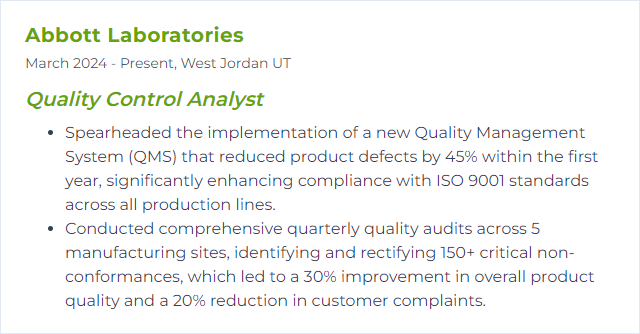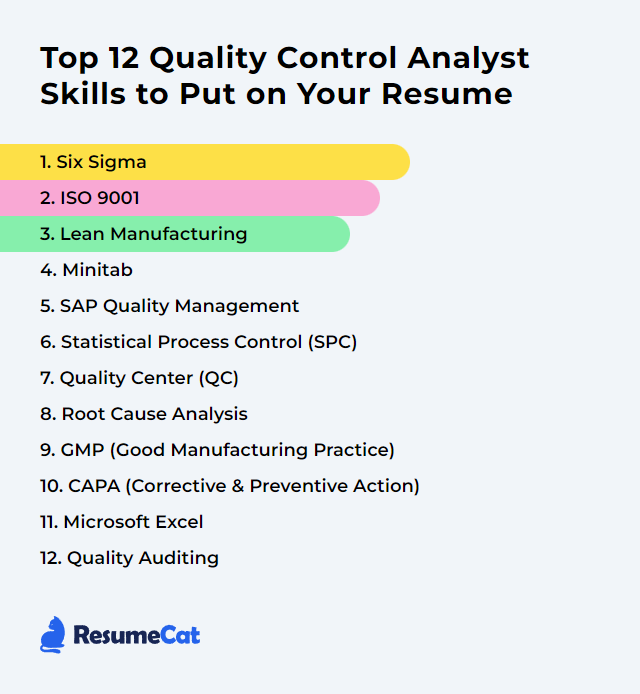Top 12 Quality Control Analyst Skills to Put on Your Resume
In quality control, the right skill mix on your resume isn’t garnish—it’s the main course. Show you can protect standards, throttle defects, and keep risk on a short leash. Employers notice when your toolkit reads like a promise, not a wish list.
Quality Control Analyst Skills
- Six Sigma
- ISO 9001
- Lean Manufacturing
- Minitab
- SAP Quality Management
- Statistical Process Control (SPC)
- Quality Center (QC)
- Root Cause Analysis
- GMP (Good Manufacturing Practice)
- CAPA (Corrective and Preventive Action)
- Microsoft Excel
- Quality Auditing
1. Six Sigma
Six Sigma is a data-heavy method to cleanse processes of defects and wild swings. For a Quality Control Analyst, it means disciplined use of statistics to squeeze variation, boost yield, and anchor improvements that don’t slip.
Why It's Important
It delivers fewer defects, tighter processes, and measurable wins—lower cost, higher satisfaction, clearer decisions. The structure keeps teams honest and outcomes repeatable.
How to Improve Six Sigma Skills
Sharpen the method, sharpen the results. Try these:
Deepen your belt level: Advance through Green/Black Belt coursework and projects; reinforce tools with practice, not theory alone.
Work the DMAIC spine: Define crisply, measure with rigor, analyze with stats, improve with evidence, control with dashboards and SOPs.
Level up statistical tools: Become fluent with control charts, capability analysis, regression, DOE, and software like Minitab.
Build soft-skill muscle: Clear communication, facilitation, change leadership—your projects rise or fall on adoption.
Stay current: Follow industry publications, case studies, and peer forums to pick up fresh patterns and pitfalls.
Practice on real pain: Choose problems with cost-of-poor-quality bite. Small pilots, quick wins, then scale.
Find a mentor: Partner with an experienced Black Belt or program lead; get feedback on scoping, analysis, and control planning.
How to Display Six Sigma Skills on Your Resume

2. ISO 9001
ISO 9001 sets requirements for a quality management system. It’s the skeleton: process control, documentation, risk-based thinking, and continual improvement that help organizations meet customer and regulatory demands—reliably.
Why It's Important
It aligns teams on how work should be done, measured, and improved. That consistency is a gift to a Quality Control Analyst hunting variation and nonconformance.
How to Improve ISO 9001 Skills
Strengthen the QMS and your impact grows:
Keep learning: Track revisions, interpretations, and auditing practices through reputable quality bodies and training programs.
Elevate documentation: Clear procedures, version control, evidence trails, and change history—tight paperwork prevents audit heartburn.
Build feedback loops: Pull input from customers, operators, and suppliers; feed it into risk reviews and corrective actions.
Audit with intent: Plan internal audits against ISO 19011 guidance; prioritize risk and process performance, not checklists alone.
Grow a quality culture: Share metrics, celebrate corrections caught early, and embed ownership at the process level.
Apply improvement tools: Lean, Six Sigma, 5S, mistake-proofing—pick what fits and measure the change.
Use the right tech: A QMS platform that manages docs, training, CAPA, and audits keeps the system humming.
How to Display ISO 9001 Skills on Your Resume
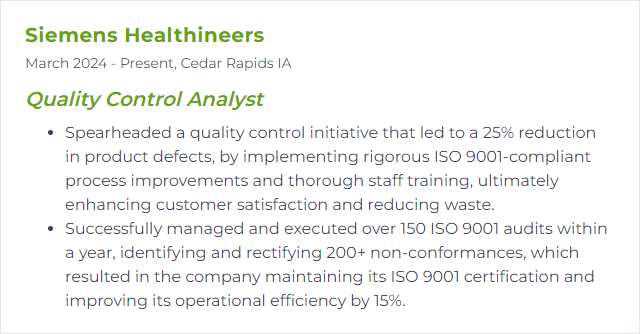
3. Lean Manufacturing
Lean strips out waste—time, motion, defects, inventory—so value flows. For quality control, it means fewer failure points, clearer standards, and processes that behave.
Why It's Important
Less waste, better quality, faster response. You spend more time preventing issues and less time mopping them up.
How to Improve Lean Manufacturing Skills
Make it visible, simple, and relentless:
Kaizen every day: Encourage small, frequent fixes from the people closest to the work; harvest them quickly.
5S the workplace: Sort, set in order, shine, standardize, sustain. Clean workspaces catch defects before they hide.
Blend in Six Sigma: Reduce variation while you reduce waste—dual engines, one flight path.
Standardize work: Document best-known methods, train to them, and verify adherence with layered audits.
Use data in real time: Dashboards, alerts, andon signals—problems surface fast, response gets faster.
Drive root cause: 5 Whys, fishbone, FMEA—fix causes, not symptoms, and lock gains with error-proofing.
Partner with suppliers: Share specs, scorecards, and corrective actions to tighten incoming quality.
Cross-functional crews: Engineering, ops, quality, maintenance—one team, one takt, fewer handoffs lost in the noise.
How to Display Lean Manufacturing Skills on Your Resume
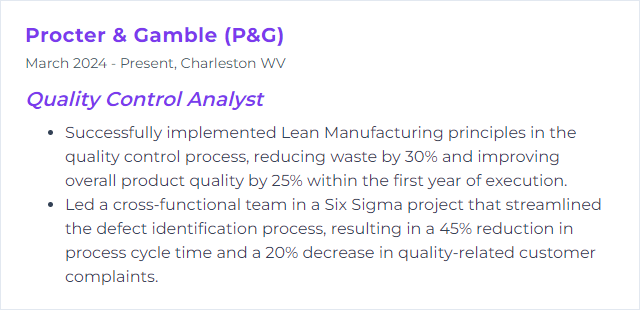
4. Minitab
Minitab is a statistics workbench for quality pros—control charts, capability, regression, DOE, and more—built to make analysis faster and decisions sturdier.
Why It's Important
It turns messy data into clear signals, helps spot drift early, and backs up recommendations with evidence instead of hunches.
How to Improve Minitab Skills
Go beyond buttons—own the methods:
Nail the fundamentals: Distributions, sampling, hypothesis tests, SPC, capability. Theory first, then application.
Specialize in quality tools: X̄-R, I-MR, P/NP, C/U charts; gage R&R; tolerance intervals; DOE screening and optimization.
Practice with real datasets: Recreate past projects, simulate noise, compare outcomes; build intuition.
Explore automation: Use macros and templates for repeat analyses; standardize reports.
Track new features: Stay current on releases and tips to keep workflows sharp.
Engage the community: Swap examples, sanity-check approaches, and learn odd edge cases from peers.
How to Display Minitab Skills on Your Resume
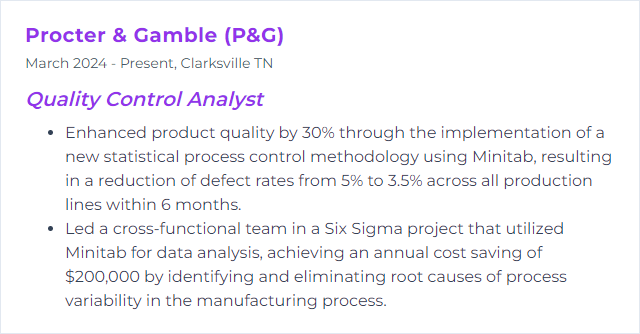
5. SAP Quality Management
SAP Quality Management (QM) in SAP ERP and SAP S/4HANA ties planning, inspection, nonconformance, and CAPA into the same backbone as production and materials. One source of truth, fewer gaps.
Why It's Important
Quality events get captured where they happen. Analysts can prevent, detect, and correct using integrated data—faster, cleaner, auditable.
How to Improve SAP Quality Management Skills
Turn the module into a force multiplier:
Standardize inspections: Build robust master data—inspection plans, characteristics, sampling procedures—and drive consistency across plants.
Use analytics: Create KPIs and dashboards for defect trends, vendor performance, cost of quality, and closure rates.
Automate notifications: Streamline quality notifications and workflows so escalations and tasks don’t stall.
Train deeply: Go beyond navigation—cover configuration impacts, integration points, and user acceptance.
Integrate broadly: Connect QM with MM, PP, EWM, and EHS for end-to-end traceability and faster dispositioning.
Keep systems current: Apply updates, validate critical processes, and retire customizations that add friction.
Close the loop: Feed lessons from defects and audits into specs, training, and supplier controls.
How to Display SAP Quality Management Skills on Your Resume
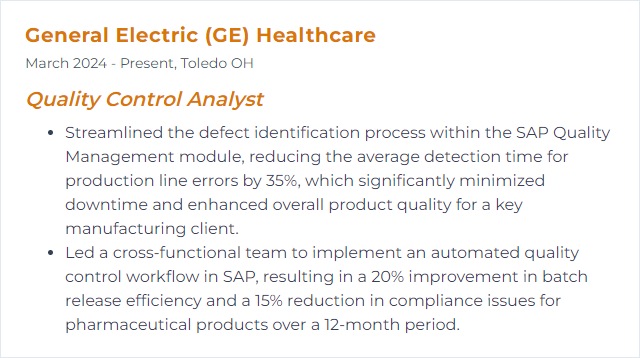
6. Statistical Process Control (SPC)
SPC watches process behavior using statistics so you catch special causes before they become scrap. It’s control charts, capability, signals, and swift responses.
Why It's Important
You move from firefighting to foresight. Stable processes make predictable products, and customers breathe easier.
How to Improve Statistical Process Control (SPC) Skills
Make your charts tell the truth and tell it early:
Strengthen training: Ensure teams grasp variation types, control limits, and rules for out-of-control signals.
Collect clean data: Calibrated instruments, clear sampling, automated capture when possible; garbage in, false alarms out.
Map the process: Visualize flow, inputs, and risks; place charts where they matter, not where they’re convenient.
Choose the right charts: Attribute vs. variable, subgroup sizes, rational subgrouping—fit the method to the data.
Do root cause fast: When a rule breaks, investigate immediately with 5 Whys, fishbone, or short DOEs.
Adopt continuous improvement: Review chart performance, refine sampling, and eliminate chronic noise sources.
Leverage SPC software: Use tools that support real-time alerts, drill-downs, and standardized reporting.
Communicate: Share results visually at the line; empower operators to act without waiting.
How to Display Statistical Process Control (SPC) Skills on Your Resume
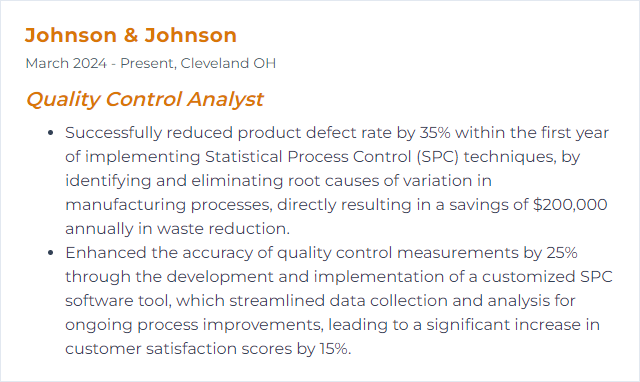
7. Quality Center (QC)
ALM/Quality Center, now part of OpenText (formerly HP ALM/Micro Focus ALM), is a platform for managing requirements, tests, defects, and releases. It gives Quality Control Analysts traceability from what’s promised to what’s proven.
Why It's Important
Centralized testing, tighter defect tracking, and clear reporting mean fewer surprises and cleaner releases.
How to Improve Quality Center (QC) Skills
Make the lifecycle visible and disciplined:
Unify artifacts: Keep requirements, tests, and defects linked; enforce naming, versioning, and ownership.
Automate smartly: Pair with automated testing tools to raise coverage and speed up regression checks.
Elevate reporting: Build dashboards with cycle time, pass/fail trends, defect aging, and escape rates.
Adopt best practices: Reuse test assets, control environments, peer-review test cases, and prune redundancy.
Keep learning: Track product updates, new integrations, and evolving test methods.
Tight feedback: Close the loop between testers, developers, and product owners; shorten time-to-fix.
Integrate toolchains: Connect with issue trackers like Jira and CI/CD pipelines for seamless flow.
How to Display Quality Center (QC) Skills on Your Resume
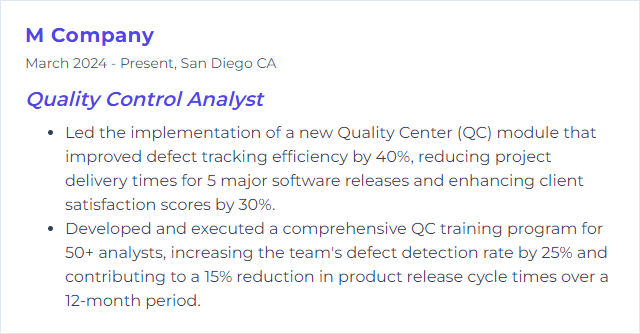
8. Root Cause Analysis
RCA digs past the symptom to the culprit. The goal: fixes that stick, not bandages that peel off under pressure.
Why It's Important
It prevents recurrence, shrinks downtime, and protects customers. Quality matures when causes are removed, not merely recorded.
How to Improve Root Cause Analysis Skills
Be systematic, fast, and evidence-driven:
Frame the problem: Tight problem statements with scope, impact, and observable facts.
Use structured methods: 5 Whys, Ishikawa diagrams, FMEA, Pareto—choose tools that fit the failure mode.
Collect the right data: Time-stamps, conditions, environmental context; don’t skimp on measurement fidelity.
Bring the right people: Operators, engineers, quality, maintenance—diverse insight unclogs blind spots.
Validate root causes: Test hypotheses with small experiments or data cuts before rolling out big fixes.
Lock in controls: Error-proofing, checkpoints, and monitoring plans; verify effectiveness over time.
How to Display Root Cause Analysis Skills on Your Resume

9. GMP (Good Manufacturing Practice)
GMP lays down how products are made and controlled so they’re safe, consistent, and traceable. For a Quality Control Analyst, it’s strict procedures, clean documentation, validated methods, and an audit trail that stands up.
Why It's Important
Testing alone can’t save a bad process. GMP prevents errors upstream, then proves compliance downstream—protecting patients and consumers.
How to Improve GMP (Good Manufacturing Practice) Skills
Make compliance practical and alive:
Track regulations: Monitor updates from health authorities and standards groups; align SOPs promptly.
Train continuously: Role-based training, qualification checks, and refreshers tied to deviations and change control.
Strengthen QMS: Robust document control, training records, deviation/CAPA, change management, and audit programs.
Audit routinely: Internal audits and gap assessments that focus on data integrity, aseptic practices, and validation status.
Champion quality culture: Encourage reporting, reward early catches, and remove fear from escalation.
Use reliable tech: Qualified instruments, validated software, and secure data systems to meet data integrity principles.
Document like it matters: ALCOA+ principles—attributable, legible, contemporaneous, original, accurate, plus complete and consistent.
Act on signals: Investigate complaints, audit findings, and deviations quickly; verify CAPA effectiveness.
How to Display GMP (Good Manufacturing Practice) Skills on Your Resume
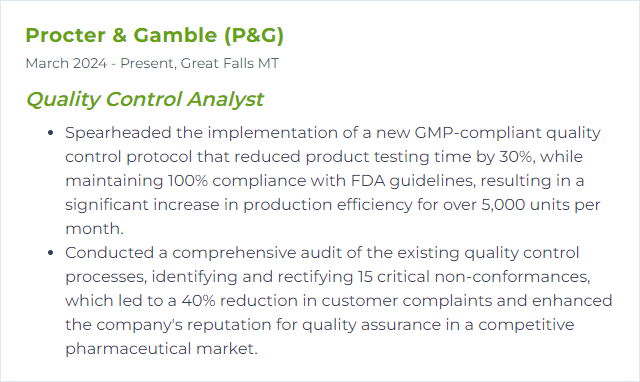
10. CAPA (Corrective and Preventive Action)
CAPA is the disciplined loop for fixing what went wrong and blocking it from returning. Corrective for today’s wound, preventive for tomorrow’s risk.
Why It's Important
It turns incidents into improvements, strengthens compliance, and reduces cost of quality. Without CAPA, problems echo.
How to Improve CAPA (Corrective and Preventive Action) Skills
Keep the loop tight and testable:
Identify and log clearly: Trend data to spot systemic issues; define problems with scope and evidence.
Prioritize by risk: Use structured risk assessment (aligned with ISO 31000 principles) to focus effort where it matters.
Build solid plans: Actions should be specific, measurable, achievable, relevant, and time-bound with clear owners.
Execute with control: Track tasks, resources, and dependencies; remove blockers quickly.
Verify effectiveness: Confirm outcomes with data and time; if results slip, iterate the fix.
Document and communicate: Maintain clean records, share lessons learned, and update procedures and training.
Embed PDCA: Plan-Do-Check-Act keeps momentum and prevents backsliding.
How to Display CAPA (Corrective and Preventive Action) Skills on Your Resume
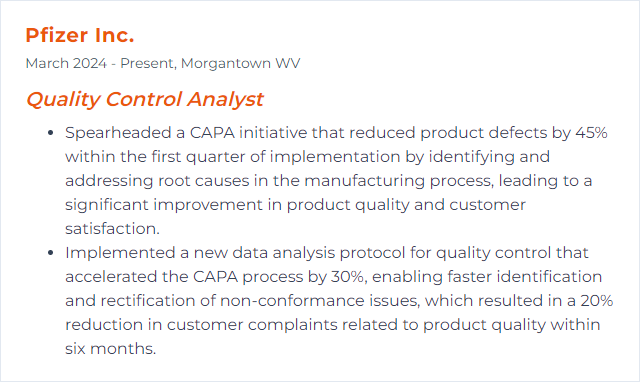
11. Microsoft Excel
Excel is the everyday lab bench for data—cleaning, analysis, and visuals. For a Quality Control Analyst, it’s quick checks, ad hoc studies, and shareable dashboards.
Why It's Important
Fast insights, repeatable calculations, and clear charts. You spot trends, outliers, and errors before they metastasize.
How to Improve Microsoft Excel Skills
Trade clicks for craft:
Master advanced formulas: XLOOKUP, INDEX/MATCH, SUMIFS, COUNTIFS, dynamic arrays (FILTER, UNIQUE, SORT).
Pivot like a pro: PivotTables and PivotCharts for slicing data, drill-downs, and executive summaries.
Enable statistical add-ins: Use the Analysis ToolPak or dedicated tools for quick hypothesis tests and regressions.
Power Query for ETL: Automate data import, cleanup, and reshaping from multiple sources.
Macros and VBA: Script repetitive tasks, create custom functions, and standardize reports.
Visual storytelling: Build interactive dashboards with slicers, conditional formatting, and sparklines.
Guard data integrity: Data validation, error checks, protection, and audit trails for reliable analysis.
How to Display Microsoft Excel Skills on Your Resume
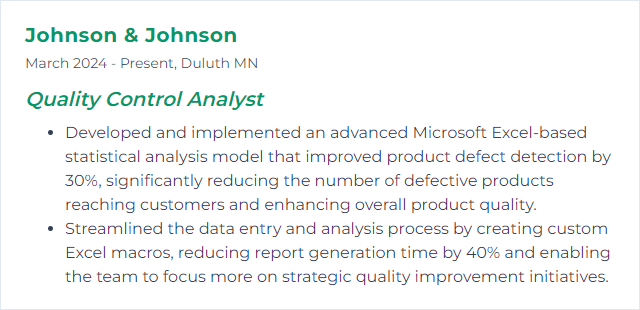
12. Quality Auditing
Quality auditing is a systematic look under the hood of your quality system—standards, procedures, records—to verify compliance and find leverage points for improvement.
Why It's Important
Audits validate trust. They also surface weak links before customers or regulators do.
How to Improve Quality Auditing Skills
Raise the bar on both rigor and rapport:
Stay aligned with standards: Keep current on ISO requirements and sector regulations so criteria don’t drift.
Grow auditor competencies: Critical thinking, sampling strategies, interviewing, and evidence evaluation.
Digitize the workflow: Use audit management tools for planning, checklists, findings, and follow-up tracking.
Communicate openly: Set expectations, avoid surprises, and collaborate on pragmatic corrective actions.
Continuous improvement: Trend findings, address systemic issues, and refine your audit program each cycle.
How to Display Quality Auditing Skills on Your Resume
